How much does microblading cost?
I charge $500 for the complete microblading procedure. This includes two sessions. The first session is where I design your brows, and add the first layer of microblade strokes. The second session is where I add additional strokes at different angles, to create a full and natural effect. These two sessions are scheduled 4 weeks apart.
If we haven’t met, or you are not sure microblading would be right for you, I am happy to answer any questions you might have. We can either speak on the phone, or arrange a brief consultation at the salon. It is always a good idea to be familiar with the person who will be designing your brows. (I’ve heard of people who sign up for bargain priced microblading on Groupon, and have no idea who their artist will be!) Microblading is and ART, as much as a technical skill. So, if you are researching the procedure, and aren’t sure who to select as your artist, a preliminary consultation is a great idea!
How often will my new eyebrows need to be touched-up?
Over time, as the color begins to lighten, a touch-up session can be scheduled with your microblade artist, to re-apply a fresh layer of pigment. On average, a touch-up is needed every 9-12 months, but this varies depending on how quickly a person’s skin turns over, and on the color of the pigment used. A touch-up keeps the hair strokes looking crisp and defined, and preserves the desired color and tone of the brows. I charge $200 for a touch up.
What are the causes of eyebrow hair loss?
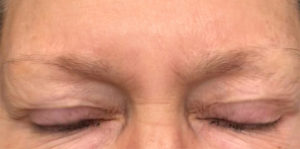 |
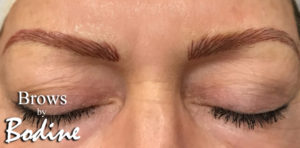 |
1. Thyroid: Thyroid issues are a frequent causes of eyebrow hair loss. For people with chronic thyroid related eyebrow thinning or hair loss, the Brows by Bodine Microblading studio in Dallas, TX, offers a simple solution with beautiful, long-lasting results. Because microblading allows the artist to replicate individual hairs with semi-permanent cosmetic pigment, it is possible to fill in the missing area of the brows in a way that blends beautifully with the remaining eyebrow hair, to create a full brow effect.
2. Alopecia: Alopecia is a condition of the immune system that causes the body to attack the hair follicles, which will ultimately inhibit normal hair growth. Even with treatment, over time Alopecia can result in total eyebrow hair loss. Dallas area clients can schedule an appointment with Don Bodine to see the type of results microblading can give to a person who has completely lost their eyebrows. Don can use a wax pencil to demonstrate the type of results that the client can expect from microblading. Eyebrows are an essential part of facial expression, and even a even a very light and subtle eyebrow shape can transform the features of the face.
3. Chemotherapy and radiation treatments for cancer. Aggressive cancer treatments often result in hair loss. This loss can be temporary, or permanent. After cancer treatment, microblading offers an ideal solution for immediately filling in the brow area that may have lost it’s hair. The microblading will not interfere with hair re-growth, so it is possible that the brows will fill in naturally over time. If the brows do not fully re-grow, microblading can add the extra density needed to have a full brow shape, without having to spend time creating it with cosmetics every day.
4. Age related hair loss. There is a degree of hair loss that is natural, and can be expected as a person ages. Ideal nutrition can help to reduce this, but there will come a point for most people where the shape and density of their brow will be reduced. In the same way that hair color, or skin care treatment to minimize wrinkles can give an instant age-reducing effect; restoring the shape and density of the eyebrows can instantly make a person look years younger.
5. Hormone and Stress related hair loss.
6. Loss of Pigment. Even when the hair follicles are still healthy, grey or blonde hairs can seem invisible against fair skin. Microblading is an ideal solution, because the microblade pigment can define the shape of the brows, and give depth of brow color under the surface, and the lighter colored hair can continue to grow on top. The effect is a natural and fluffy brow effect. Microblading is a topical procedure, and does not effect the hair follicle. So, the two can be layered together for a natural and beautiful effect.
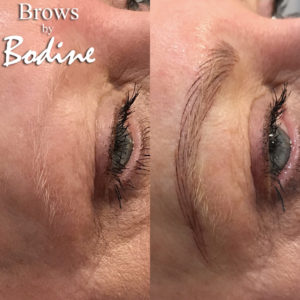
Does Microblading hurt?
No. Microblading should be completely comfortable if the artist uses the correct topical anesthetics, and takes the time to allow the brow area to become fully numb, before beginning the procedure. If you have read stories of painful microblading experiences, the most common cause was that the microblade artist did not allow sufficient time for the anesthetic to work. The other mistake some artists make is to assume that all skin types will respond equally well to the same anesthetic products. Don has different protocols for thin skin, sensitive skin, thick skin, oily skin, etc…. With careful numbing technique, EVERY client’s brow area can become fully numb. Don is committed to taking whatever time necessary to make the whole experience of microblading comfortable and enjoyable.
Does Don use disposable (single-use) microblade tools?
Yes. ALL procedure supplies are single-use and disposable. Don’s microblade pens are single-use, individually wrapped, and sterilized with EO gas. The pigments are sterile, professional grade permanent-cosmetic pigments. Cotton pads are individually wrapped and sterile, and Don uses an anti-microbial cleansing wipe throughout the microblade session, to remove excess pigment and clean the brow area. Don is certified in industry hygienic standards, and his salon studio is licensed as a tattoo studio by the State of Texas.
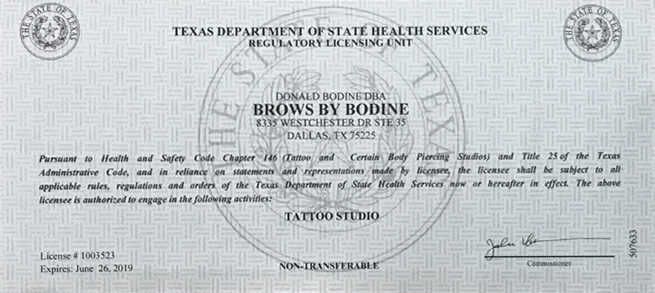
Can microblading be done over a scar in the brow area?
Yes, a scar in the brow area can be filled in with microblade pigments, to create a full, even brow shape.
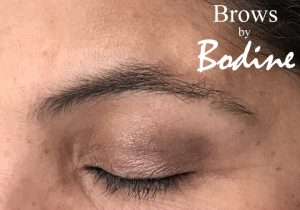 |
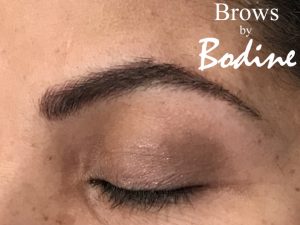 |
Does microblading affect the brow hairs??
No. Because microblading is a shallow procedure, it does not damage the roots of the brow hairs that are present in the area being microbladed. Microblading can be very effective in adding extra density to an area that has sparse brows.
What are the benefits of Microblading versus eyebrow tattoos?
Eyebrow Microblading is a semi-permanent procedure, that deposits pigment just under the surface of the skin. Technically, it aims for the space between the lower epidermis and the upper dermis. Because this layer of skin is constantly regenerating and shedding, over time the pigment will disappear as the skin turns over. This process takes 1-2 years, depending on the thickness of the skin, and the speed at which the person’s skin regenerates.
Eyebrow Tattoos deposit pigment beneath the dermis of the skin, where it will remain permanently. Over time, the pigment will fade, and the color will become lighter, often turning gray, blue, green, or a pinkish tone. As the color becomes lighter, one option is to re-tattoo the area. Tattooing the skin repeatedly will result in an accumulation of pigment and scar tissue under the skin, which will inhibit future pigment retention. Over time, the tattoo pigment gradually spreads and softens, and the color fades.
Can microblading cover an old tattoo?
Microblading is a great option for covering faded tattoos, and restoring a more natural brow appearance. Depending on the intensity of the tattoo pigments, it may be possible to microblade directly over the tattoo, and achieve good coverage. If the tattoo is dark, it may be advisable to have laser tattoo removal first. If you have eyebrow tattoos, you can send me a photo of your brows, or schedule a consultation to see if microblading would be a good option for you.
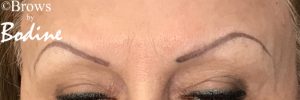 1.This client’s brows were tattooed 20 years ago
1.This client’s brows were tattooed 20 years ago
 2. Don designed the new brow shape to cover the old tattoo
2. Don designed the new brow shape to cover the old tattoo
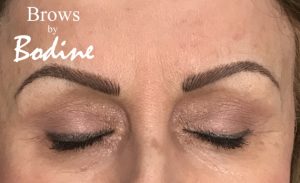
3. After microblading
Is the color custom mixed for each client?
Yes, I mix the pigments for each client, based on their hair color, skin tone, and their desired brow look. Generally, brows should be similar to the undertones of the hair (brows shouldn’t match the highlights). However, some clients have very particular color preferences, and I always work to give the client the brow shape and color that THEY want.

Two of my Microblading clients: Carl and Linda. The color, size and shape of their of their brows is customized to match their individual features..
How will the brows look while they are healing?
Immediately following the procedure, the brows will be somewhat red, similar to after brow-waxing. During the first week, when the brows are healing, the color will appear darker, and more intense. After healing, the pigment will be covered by a transparent layer of skin, which will soften the intensity of the color….usually by about 40%. You can go to work the next day. They will be a little darker than the final result, but they will look fine, and you will probably get compliments right away!
What are the recommended aftercare procedures for protecting the brows during the healing process?
I provide detailed aftercare instructions for each client, depending on their skin type. There are different methods of protecting the brows, depending on how oily or dry the person’s skin is. In general, the most important points of the aftercare instructions are:
-To protect the brow area from the Sun during healing
-To avoid picking or rubbing the tiny scabs that form above the microblade strokes, so they can dissolve away naturally
-To avoid soaking the brow area with excessive moisture during healing (No hot-tubs, sauna, long-hot showers, etc…)
I provide detailed instructions for how to clean the brow area, and I provide each client with an aftercare balm to keep the brows moisturized for quicker healing. Healing takes approximately one week, but varies significantly from person to person. You will know the healing is complete when the tiny scabs have dissolved away, leaving the skin perfectly smooth, and the color of the pigment has softened.
Are there certain products or facial treatments that I need to avoid before microblading?
Yes. I also provide a complete list of how to prep the skin for microblading. Some highlights are:
-Avoid Retinols, Glycolic acid, or other chemical exfoliators on the brow area for 3-4 weeks before microblading.
-Avoid sun-tanning the week before.
-Avoid blood thinners such as Aspirin, Ibuprofen, and Alcohol 24 hours before.
The skin should be clear, healthy, and non-irritated for the best results. A complete checklist is provided when we schedule your microblade procedure.
Does Microblading work for Men’s brows?
Yes! Men’s brows are shaped differently (lower, with less arch). Men’s brows become thinner over time, and filling in the brows can significantly enhance a man’s appearance.
How can a person test to make sure they have no allergies to Microblade pigments?
If you would like to take an allergy test, I can mail you a small vial with a couple drops of pigment. You can apply this to a clean area on the inside of your arm, let it sit for a minute, and then wipe it off. You can then monitor the skin for the next couple days to be sure that you have no allergic reaction. Testing for allergies is a great idea for anyone, but is especially important for people who have had allergic reactions to cosmetic products (particularly eye shadows), or people with allergies to vegetables or minerals. Microblade pigments are sterile, Vegan, and gluten-free.
Am I a candidate for Microblading?
As long as you are at least 18 years of age, and are relatively healthy, almost anyone can be a good candidate.
You are NOT good candidates for microblading if you:
- Are under the age of 18.
- You take Coumadin or Heparin (These blood thinners cause excessive bleeding, and will inhibit color retention)
- Have any communicable blood borne infection, such as Hepititus, HIV, MRSA, etc…
- Are being treated for Cancer (Cancer must be in remission, and you are released form a Doctor’s care).
- Are pregnant or breastfeeding.
- Have trichotillomania (Hair Pulling Disorder). Picking at the microblading procedure can cause infection.
- Have active skin diseases (such as psoriasis, eczema, or an undiagnosed rash) near the brow area, or have a history of facial shingles.
- Diabetic (with doctors approval)
- Epilepsy
- A Pacemaker, or major heart problems
- Had an organ transplant
- Sever skin allergies
- Don’t heal well, and develop infections easily
- Are allergic to Lidocaine, Benzocaine, Tetracaine, or other topical anesthetics.
- If you are allergic to makeup or pigments, it is recommended you stop by for an allergy test with the eyebrow pigments. We can schedule this a week or two before the procedure.